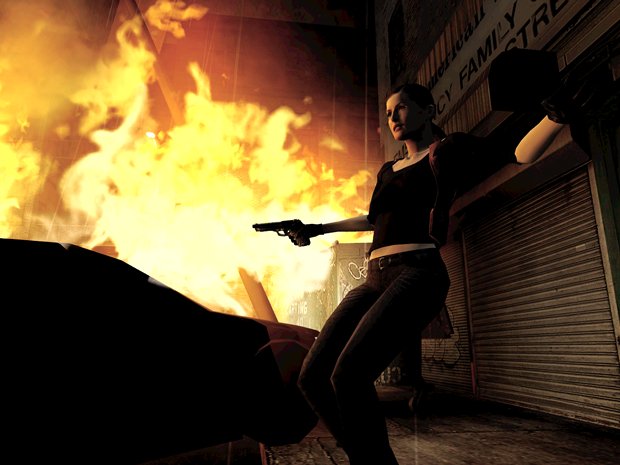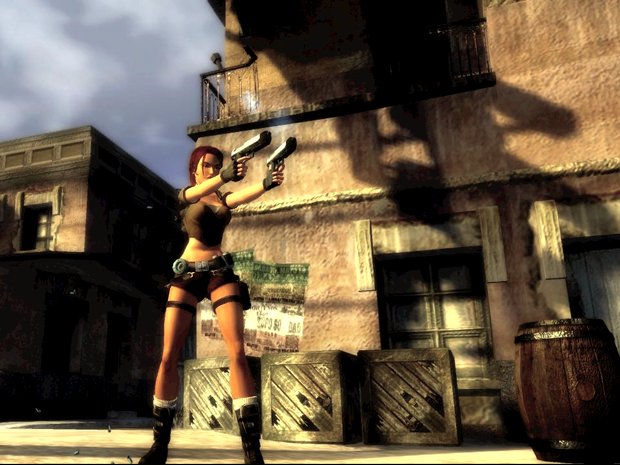A videogame history of bullet-time
Let's rake through the past of the most enduring of gimmicks. In slow-motion
2001 - Max Payne

This is where all the tricks of the trade coagulated into one big, beautiful, tortured slow-motion glory shot. Few can forget the first moment they tapped the relevant key in the training level, the whooshing noise that heralded bullet-time, the half-spoken cry of, “It’s Payne!” from the gangsters turning the street corner, and the glorious tracking of the bullets that would finish them off. In time, mods would not only implant Matrix-style kung-fu moves but also the fateful Lobby scene that Max had been born to ape. A landmark in extreme gaming violence. Hurrah.
2002 - Jedi Outcast

Sure Obi-Wan never danced around Vader in giddy circles, but that didn’t stop Kyle Katarn from presenting himself with a dose of Force Speed whenever he wasn’t using his powers to knock stormtroopers off high ledges. At the time of Jedi Outcast the bullet-time train was really rolling, so full-on spinny slo-mo cameras were used when you offed lightsaber-wielding enemies, while more traditional world-slowing techniques could be enforced on your surroundings during more general combat.
2003 - Max Payne 2: The Fall of Max Payne

What better way to improve the unsubtle art of slow-motion than have all manner of on-screen paraphernalia and physics imbued bodies flying all over the shop? Max Payne 2 was keen to impress, and so was heavy on situations in which, for example, someone left thirty plastic chairs sitting on an explosive crate. It turned out that flaming barrels and enemies precariously balancing on scaffolding made for even better bullet-time. Who knew?
2003 - Enter the Matrix
Weekly digests, tales from the communities you love, and more

Unfortunately, the official Matrix game had the very worst implementation of bullet-time around. As you played through the game you could easily forget you had slow-motion chopsocky or bullet-dodges, as the bad enemy AI and your overpowered character rarely made it necessary to perform in the usual digital goop. Compared toMax Payne’s Kung Fuand an unofficial mod that recreated the simple joy of The Matrix’s lobby sequence, the official game felt little more than lightweight fluff. The fact that Enter the Matrix was so up itself and devoid of fun would prove to be an indication of the way the whole franchise was going. Sometimes guns - lots of guns - are not enough.
2005 - Doom 3: Resurrection of Evil

By the time the Doom 3 expansion pack rolled around, the bullet-time production line had become an efficient and ubiquitous industry. True to form, Resurrection appeared late to the party with both and performed with neither. Repackaged as Helltime (patent pending) it looked pretty, but added little to the game. A pattern that would be repeated in games for several years.
2005 - FEAR

FEAR was the game where bullet-time tweaked the details to a new level. Here ‘Reflex’ time made a game a show-stopping must have. FEAR’s particle effects, flying sparks and the beautiful animation of your enemies’ leaps and vaults were visceral in the extreme in slow-motion, while the ability to toss a grenade and then shoot it into combustion in mid-air was an unparalleled by-line in shooter history. Whenever you hear an enemy goon say, “Shiiiiiit”, in a desperate low bass and try to run away, remember that FEAR did it first, and better.
2006 - Tomb Raider: Legend

The quest for decent Lara-on-human combat remained unfulfilled with Legend’s odd mechanic of having Lara undertake graceful slow-motion leaps hither, thither and off the barrel-chests of her gun-toting foes. Things were only marginally better when the remake of the original Tomb Raider, Anniversary, appeared one year later, and that was only because you were leaping out of the way of a dinosaur. And dinosaurs are always cool. Still though, if there’s one thing that’s not needed in a Tomb Raider game it’s slo-mo.
2007 - Call of Juarez

That cowboys have rough edges is easy to believe, but that they had the ability to slow down time – as in Call of Juarez – just didn’t meld with the Wild West action or setting. Developers Techland repeated this mistake by letting Brother Ray keep this ability in the game’s prequel, Bound in Blood. In recent times, Rockstar has nailed Wild West slow-motion shootery with the DeadEye system in Red Dead Redemption - here Techland didn’t come close.
2007 - TimeShift

Proof that the attractive sheen of bullet-time had worn off in gaming circles, TimeShift was cruelly ignored. A tight, ferocious shooter that genuinely added new and interesting gameplay to an increasingly elderly concept. Freeze enemies and steal their guns, reverse time and watch the world unwrap around you... if it had been released a few years earlier it would have been dynamite. Please, please, please check the game out on Steam, it remains a hugely satisfying game to play.
2007 - John Woo’s Stranglehod

Better on paper, and on console than on PCs, Stranglehold was nevertheless the bullet-time phenomenon coming full circle. The director who mastered the art of slo-mo combat and his iconic star, Chow Yun Fat, entered the realm of gaming with a game-only sequel to the masterpiece Hard Boiled. The physics and the sheer cinematic pizzazz of its bullets caught in motion were a joy, yet the rest of the game didn’t do its cinematic predecessor justice.


